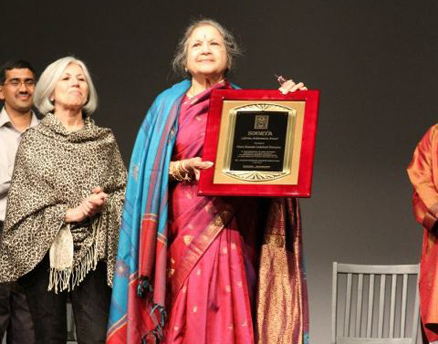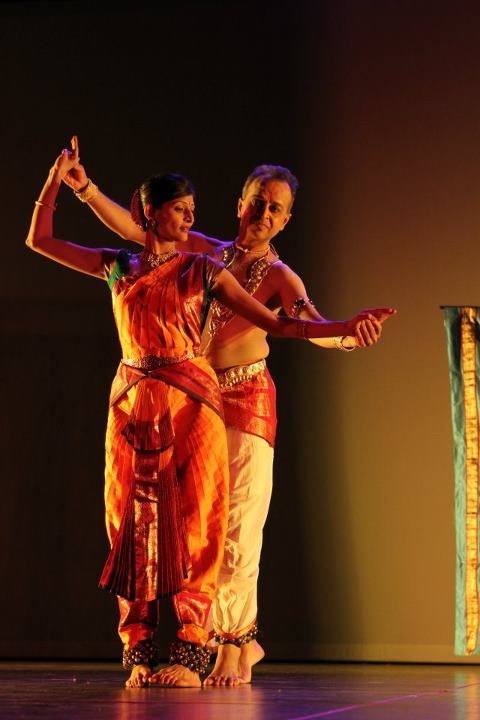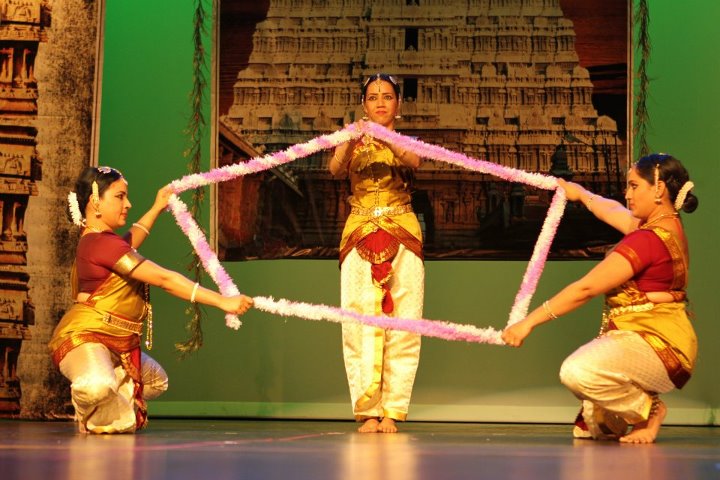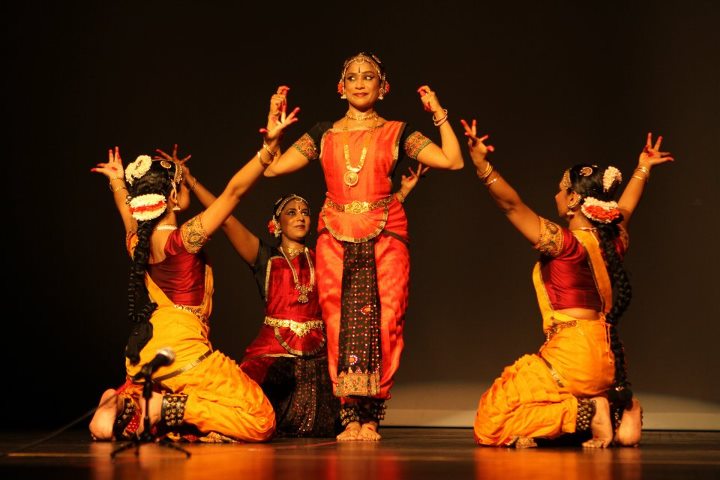
Woodland Hills,California
Should one stick to tradition or should they adopt new practices which yield new tradition? This is a challenging question for the current generation of Indian classical dancers. The purists argue about keeping the structure as is, while experimentalists argue that they should build new experiments using old relics or with new objects. One thought is like that of a museum, which holds artifacts, and the other is like new modern architecture. The existence of Indian classical dance in the United States owing to the immigrant NRI population was put to question at the fourth St. Louis Indian Dance Festival, which provides a platform to mostly U.S.-based Indian classical dancers. Issues related to pedagogy of Indian classical dances and their presentation in the western nation, like the United States, were raised at this year’s festival.
The event spanned three days and presented many talented dancers and experienced dance Gurus on one stage. It also featured a seminar on “Future of Indian Classical Dances,” which focused on the significance of an Indian origin individual learning classical Indian dance forms over an American learning the same styles of dance. The lively discussions highlighted the differences and presented plausible suggestions from teachers, parents, members of the audience as well as the organizers. Events scheduled in the evening were attended by more than 1,200 people.
More than 25 different dance performances in the popular Bharatnatyam, Kathak, Odissi and Kuchipudi styles were presented at the festival, including some fusion dance performances in Bharatnatyam-Mohini Attam, Bharatnatyam-Jazz and Poetical Bharatnatyam with English poems. While known dancers like Prashanth Shah, Nirmala Madhava, Ramya Ramnarayan and Srilatha Suri presented traditional items, others like Guru Prasanna Kasthuri, Savitha Sastry and Sushma Mohan showcased productions incorporating newer themes. Talented dancers such as Shipra Avantica Mehrora, Answesha Das and Rachana Madhav Rao recreated new choreographies through their traditional dance base. Dancers had flown in from Canada, India, California, New York, New Jersey, Philadelphia, Texas, Kansas, Chicago and Seattle, as well as from the home town St. Louis, MO.
A Lifetime Achievement award and cash prize was presented to dancer-Guru-actress Kamala Lakshmi Narayanan at this year’s festival. Narayanan, a senior dance guru of the Vazhuvoor tradition, who is popularly known as “Baby Kamala” and “Kamala Lakshman,” was also an actress and appeared in almost 100 Tamil, Hindi, Telugu and Kannada films throughout her career. At the St. Louis Indian Dance Festival, she was honored for her teachings in the United States. She was recognized for her service to enrich the cultural phenomenon of U.S. through Indian dance forms.
A well-known legendary sitarist, Ustad Imrat Khan, son of the legendary Ustad Enayat Khan, and his younger brother Ustad Vilayat Khan, who is the foremost member of the famous Etawa Gharana (musical dynasty), honored Narayanan.
Aroon Shivdasani, president of Indo American Arts Council, N.Y., who was also present at the occasion admired Guru Prasanna’s efforts to spread the word about Indian classical arts. A video highlighting the major achievements of Narayanan was showcased at the event to felicitate her.
The “Youth Dance Series” presented young Bharatanatyam dancer Bharatha Ram from San Antonio; Kuchipudi dancers Pranathi and Pranamya from Dallas; Shyama Iyer from Louisville; and Deepti Yogananada from Indianapolis. The young dancers were promising, talented and have the makings of professional dancers with the right support, said a press release. All these youngsters, who are born in U.S., are very promising and show sure signs of keeping the classical tradition alive for the future.
Both mornings featured seminars on different topics relevant to the field of dance and art. Dancer Smitha Rajan spoke about issues faced by dance teachers while imparting training to American students, while NRI children wondered why it was difficult to do an expressive or “abhinaya piece” and Anwesha Das discussed the influence of language in dance. Guru Enakshi spoke about the challenges she faces while teaching Odissi in Canada and Savita Sastry spoke about connecting a classical art form to modern times. Viji Rao headed a discussion on the participation of teacher, students and parents in a dance system. Some members of the audience also questioned the economic stress on parents to get their children trained in dance and music focusing on the increased cost of training. Many also pointed out the exorbitant fees charged by visiting Indian teachers. But this was defended by dance Gurus as a payment for professionalism. The artists drew comparisons between different professions and decried the discrepancies with the audience mentalities. Most artists agreed that it would be a challenge for classical dancers to survive in the uproar of Bollywood and other multi-media onslaught. Aroon Shivdasani, the president of IAAC, suggested that only good quality work will survive the changing weathers of performing arts.
Denton, Tex.-based Dr. Prathiba Natesan discussed the influence of western styles on Indian classical dance. Vidya Venkat Ram (Bangalore, India) highlighted the use of theater techniques to enrich the classical dance presentation. Radhika Prabhu (Bangalore) spoke about the effectiveness of collaborations happening in India as she drew examples frp, ballet learning in Bangalore. Prabhu quoted her experiences from the well-known ballet presentation, “Nut cracker,” which was presented by dancers trained in Bangalore by a teacher who moved from London to India.
The most important part of the seminar was the discussion of setting up a central administration body for Indian classical dancers living in U.S. Artists gathered at the seminar agreed that it was important for dance instructors to be certified to teach any classical Indian dance form. Nirmala Madhava brought out the need for the central body to handle the issues of students in U.S. Viji Rao, who has been on the panel of many examination centers, suggested having a common syllabus. Well-known Kathak dancer Prashanth Shah hinted at the value of such a system for both dance gurus and students. Guru Prasanna Kasthuri insisted for an independent U.S.-based organization to develop the dance pedagogy, run by highly trained U.S./Canada-based artists. Participants at the seminar decided to support the formation of such an entity.
The state government of Missouri financed the event in part through its State body —Missouri Arts Council and Regional Arts Commission. Local organizations such as Abhinaya, Missouri Tamil Sangam and the Sangama Kannada Association took an active role in supporting this festival. Local businesses such as Sulekha.com, Enopi Math, USA mortgage also supported this venture. Guru Prasanna Kasthuri, artistic director of Soorya Performing Arts, who spearheaded this dance festival with support of his Board members deserves a special mention.
  
|

